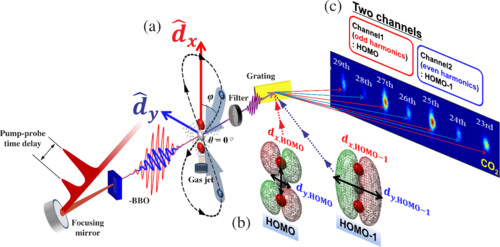Media Center
A multimedia mosaic of moments at GIST
GIST Excellence
New technology can observe the electron orbitals of a molecule
- 엘리스 리
- REG_DATE : 2015.05.18
- HIT : 795
Development of two-dimensional multiple molecular orbital observation technology (IBS-Institute for Basic Science Research Center and APRI-Advanced Photonics Research Institute)
Researchers at the Institute for Basic Science (IBS) have developed an observation technology for multiple electron orbitals in a molecule.
High-harmonic radiation emitted from molecules in a strong laser field contains information on molecular structure and dynamics. When multiple molecular orbitals participate in high-harmonic generation, resolving the contribution of each orbital is crucial for understanding molecular dynamics and for extending high-harmonic spectroscopy to more complicated molecules.
In the process of high-harmonic generation (HHG), an electron is ionized and accelerated by an intense laser field and then recombines with the parent ion. Coherent interference between the returning electron and the molecular orbitals induces an oscillating dipole, leading to HHG. Because the oscillating dipole is sensitive to the orbital structure, the characteristics of the molecular orbital can be revealed by HHG. Ionization, the first step of HHG, is a highly nonlinear process that is very sensitive to the laser intensity and ionization potential. When multiple molecular orbitals are exposed to a strong laser field, the highest-occupied molecular orbital (HOMO) is mostly ionized and thus emits strong high-harmonic radiation.
The experiments were performed using a femtosecond Ti: sapphire laser operating at 1 kHz.
Researchers demonstrated a new method for resolving multiple molecular orbitals. Their theoretical and experimental results show that high-harmonic spectroscopy can be extended from one to two dimensions in the laboratory frame by employing an orthogonally polarized two-color laser field with aligned molecules.
Director Chang Hee Nam of IBS said, “There were limitations to the previous method, but we came up with a creative solution for two-dimensional high-harmonic spectroscopy. Two-dimensional high-harmonic spectroscopy may open a new route to investigate ultrafast molecular dynamics during chemical processes.

Schematic layout for two-dimensional high-harmonic spectroscopy for probing multiple molecular orbitals. (a) Recombination in an orthogonally polarized two-color laser field. Temporal variation of the two-color laser field is depicted as a black dashed line. Emitted odd and even harmonics are polarized to d^x and d^y, respectively. (b) Orbital structures and induced dipole moment of the HOMO and HOMO-1 in CO2. The length of the arrow indicates the relative strength of the oscillating dipole moment due to the structure. (c) The spectral image shows a typical harmonic spectrum from aligned CO2 molecules. The HOMO and HOMO-1 can be separately encoded in the odd and even harmonics by the different strength of dipole moment induced in the two-color laser field on the two orthogonal axis.

Director Chang Hee Nam (left) and Researcher Hyeok Yun
Ultra-intense Laser Science Laboratory of IBS (Director Chang Hee Nam) and Advanced Photonics Research Institute of GIST (Director Yong-Tak Lee) conducted the joint research and published the results in the Physical Review Letters online edition on April 14th, 2015.
Paper title: Resolving Multiple Molecular Orbitals Using Two-Dimensional High-Harmonic Spectroscopy
First author: Researcher Hyeok Yun of Ultra-intense Laser Science Laboratory at IBS
Corresponding author: Hyung-Tak Kim of Advanced Photonics Research Institute at GIST